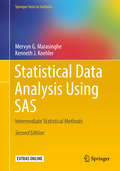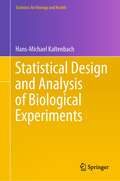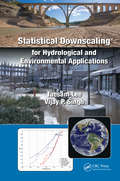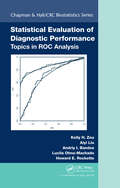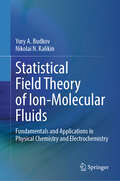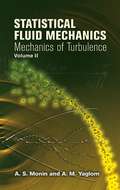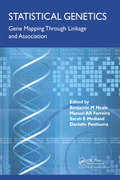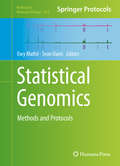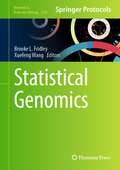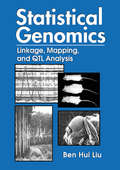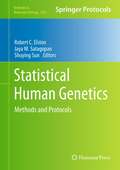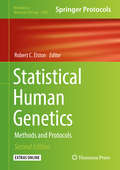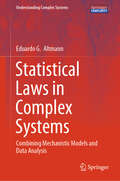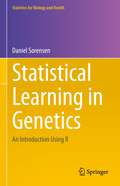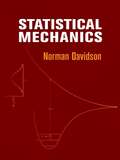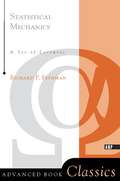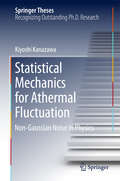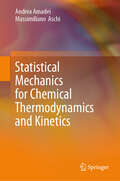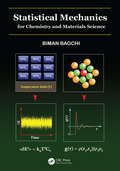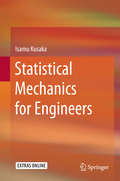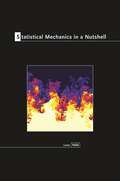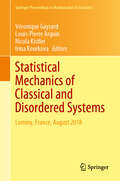- Table View
- List View
Statistical Data Analysis Using SAS: Intermediate Statistical Methods (Springer Texts in Statistics)
by Mervyn G. Marasinghe Kenneth J. KoehlerThe aim of this textbook (previously titled SAS for Data Analytics) is to teach the use of SAS for statistical analysis of data for advanced undergraduate and graduate students in statistics, data science, and disciplines involving analyzing data.The book begins with an introduction beyond the basics of SAS, illustrated with non-trivial, real-world, worked examples. It proceeds to SAS programming and applications, SAS graphics, statistical analysis of regression models, analysis of variance models, analysis of variance with random and mixed effects models, and then takes the discussion beyond regression and analysis of variance to conclude.Pedagogically, the authors introduce theory and methodological basis topic by topic, present a problem as an application, followed by a SAS analysis of the data provided and a discussion of results. The text focuses on applied statistical problems and methods. Key features include: end of chapter exercises, downloadable SAS code and data sets, and advanced material suitable for a second course in applied statistics with every method explained using SAS analysis to illustrate a real-world problem.New to this edition:• Covers SAS v9.2 and incorporates new commands• Uses SAS ODS (output delivery system) for reproduction of tables and graphics output• Presents new commands needed to produce ODS output• All chapters rewritten for clarity• New and updated examples throughout• All SAS outputs are new and updated, including graphics• More exercises and problems• Completely new chapter on analysis of nonlinear and generalized linear models• Completely new appendixMervyn G. Marasinghe, PhD, is Associate Professor Emeritus of Statistics at Iowa State University, where he has taught courses in statistical methods and statistical computing.Kenneth J. Koehler, PhD, is University Professor of Statistics at Iowa State University, where he teaches courses in statistical methodology at both graduate and undergraduate levels and primarily uses SAS to supplement his teaching.
Statistical Design and Analysis of Biological Experiments (Statistics for Biology and Health)
by Hans-Michael KaltenbachThis richly illustrated book provides an overview of the design and analysis of experiments with a focus on non-clinical experiments in the life sciences, including animal research. It covers the most common aspects of experimental design such as handling multiple treatment factors and improving precision. In addition, it addresses experiments with large numbers of treatment factors and response surface methods for optimizing experimental conditions or biotechnological yields.The book emphasizes the estimation of effect sizes and the principled use of statistical arguments in the broader scientific context. It gradually transitions from classical analysis of variance to modern linear mixed models, and provides detailed information on power analysis and sample size determination, including ‘portable power’ formulas for making quick approximate calculations. In turn, detailed discussions of several real-life examples illustrate the complexities and aberrations that can arise in practice.Chiefly intended for students, teachers and researchers in the fields of experimental biology and biomedicine, the book is largely self-contained and starts with the necessary background on basic statistical concepts. The underlying ideas and necessary mathematics are gradually introduced in increasingly complex variants of a single example. Hasse diagrams serve as a powerful method for visualizing and comparing experimental designs and deriving appropriate models for their analysis. Manual calculations are provided for early examples, allowing the reader to follow the analyses in detail. More complex calculations rely on the statistical software R, but are easily transferable to other software. Though there are few prerequisites for effectively using the book, previous exposure to basic statistical ideas and the software R would be advisable.
Statistical Downscaling for Hydrological and Environmental Applications
by Vijay P. Singh Taesam LeeGlobal climate change is typically understood and modeled using global climate models (GCMs), but the outputs of these models in terms of hydrological variables are only available on coarse or large spatial and time scales, while finer spatial and temporal resolutions are needed to reliably assess the hydro-environmental impacts of climate change. To reliably obtain the required resolutions of hydrological variables, statistical downscaling is typically employed. Statistical Downscaling for Hydrological and Environmental Applications presents statistical downscaling techniques in a practical manner so that both students and practitioners can readily utilize them. Numerous methods are presented, and all are illustrated with practical examples. The book is written so that no prior background in statistics is needed, and it will be useful to graduate students, college faculty, and researchers in hydrology, hydroclimatology, agricultural and environmental sciences, and watershed management. It will also be of interest to environmental policymakers at the local, state, and national levels, as well as readers interested in climate change and its related hydrologic impacts. Features: Examines how to model hydrological events such as extreme rainfall, floods, and droughts at the local, watershed level. Explains how to properly correct for significant biases with the observational data normally found in current Global Climate Models (GCMs). Presents temporal downscaling from daily to hourly with a nonparametric approach. Discusses the myriad effects of climate change on hydrological processes.
Statistical Evaluation of Diagnostic Performance: Topics in ROC Analysis (Chapman & Hall/CRC Biostatistics Series)
by Kelly H. Zou Aiyi Liu Andriy I. Bandos Lucila Ohno-Machado Howard E. RocketteStatistical evaluation of diagnostic performance in general and Receiver Operating Characteristic (ROC) analysis in particular are important for assessing the performance of medical tests and statistical classifiers, as well as for evaluating predictive models or algorithms. This book presents innovative approaches in ROC analysis, which are releva
Statistical Field Theory of Ion-Molecular Fluids: Fundamentals and Applications in Physical Chemistry and Electrochemistry
by Yury A. Budkov Nikolai N. KalikinThis book presents statistical physics methods based on self-consistent field theory for describing the thermodynamic properties of ion-molecular systems, including electrolyte solutions, ionic liquids, polymeric ionic liquids, and metal-organic complexes. The methods are applicable in both the bulk and at interfaces, taking into account the molecular structure of these systems. The book also provides a comprehensive analysis of the current state of art on statistical field theory for ion-molecular systems. It is primarily intended for researchers and graduate students in physical chemistry and condensed matter physics, as well as for physical chemists, physicists, and engineers interested in molecular system theory and simulation. By presenting these approaches, the book aims to enable readers to solve various problems in physical chemistry and electrochemistry using the methods described. The authors attempted to focus on specific issues and provide the necessary theoretical background. The book includes a mathematical introduction that readers can consult if they need clarification on any mathematical concepts or details omitted in the main text. In order to read the book, it is recommended that readers have a basic understanding of calculus, linear algebra, and probability theory, which can be acquired through standard university courses.
Statistical Fluid Mechanics, Volume II: Mechanics of Turbulence (Dover Books on Physics #2)
by A. S. Monin A. M. YaglomWritten by two of Russia's most eminent and productive scientists in turbulence, oceanography, and atmospheric physics, this two-volume survey is renowned for its clarity as well as its comprehensive treatment. The first volume begins with an outline of laminar and turbulent flow. The remainder of the book treats a variety of aspects of turbulence: its statistical and Lagrangian descriptions, shear flows near surfaces and free turbulence, the behavior of thermally stratified media, and diffusion.Volume Two continues and concludes the presentation. Topics include spectral functions, homogeneous fields, isotropic random fields, isotropic turbulence, self-preservation hypotheses, spectral energy transfer, the Millionshchikov hypothesis, acceleration fields, equations for higher moments and the closure problem, and turbulence in a compressible fluid. Additional subjects include general concepts of the local structure of turbulence at high Reynolds numbers, the theory of fully developed turbulence, the propagation of electromagnetic and acoustic waves through a turbulent medium, and the twinkling of stars. The book closes with a discussion of the functional formulation of the problem of turbulence, presenting the equations for the characteristic functional and methods for their solution.
Statistical Genetics: Gene Mapping Through Linkage and Association
by Danielle Posthuma Benjamin M Neale Manuel Ar Ferreira Sarah E MedlandStatistical Genetics is an advanced textbook focusing on conducting genome-wide linkage and association analysis in order to identify the genes responsible for complex behaviors and diseases. Starting with an introductory section on statistics and quantitative genetics, it covers both established and new methodologies, providing the genetic and statistical theory on which they are based. Each chapter is written by leading researchers, who give the reader the benefit of their experience with worked examples, study design, and sources of error.The text can be used in conjunction with an associated website (www.genemapping.org) that provides supplementary material and links to downloadable software.
Statistical Genomics
by Sean Davis Ewy MathéThis volume expands on statisticalanalysis of genomic data by discussing cross-cutting groundwork material,public data repositories, common applications, and representative tools foroperating on genomic data. Statistical Genomics: Methods andProtocols is divided into four sections. The first section discussesoverview material and resources that can be applied across topics mentionedthroughout the book. The second section covers prominent public repositoriesfor genomic data. The third section presents several different biologicalapplications of statistical genomics, and the fourth section highlightssoftware tools that can be used to facilitate ad-hoc analysis and dataintegration. Written in the highly successful Methods in MolecularBiology series format, chapters include introductions to theirrespective topics, step-by-step, readily reproducible analysis protocols, andtips on troubleshooting and avoiding known pitfalls. Through and practical, StatisticalGenomics: Methods and Protocols, explores a range of both applicationsand tools and is ideal for anyone interested in the statistical analysis ofgenomic data.
Statistical Genomics (Methods in Molecular Biology #2629)
by Xuefeng Wang Brooke L. FridleyThis volume provides a collection of protocols from researchers in the statistical genomics field. Chapters focus on integrating genomics with other “omics” data, such as transcriptomics, epigenomics, proteomics, metabolomics, and metagenomics. Written in the highly successful Methods in Molecular Biology series format, chapters include introductions to their respective topics, lists of the necessary materials and reagents, step-by-step, readily reproducible laboratory protocols, and tips on troubleshooting and avoiding known pitfalls. Cutting-edge and thorough, Statistical Genomics hopes that by covering these diverse and timely topics researchers are provided insights into future directions and priorities of pan-omics and the precision medicine era.
Statistical Genomics: Linkage, Mapping, and QTL Analysis
by Ben Hui LiuGenomics, the mapping of the entire genetic complement of an organism, is the new frontier in biology. This handbook on the statistical issues of genomics covers current methods and the tried-and-true classical approaches.
Statistical Human Genetics
by Robert C. Elston Shuying Sun Jaya M. SatagopanRecent advances in genetics over the last quarter of a century, especially in molecular techniques, have dramatically reduced the cost of determining genetic markers and hence opened up a field of research that is increasingly helping to detect, prevent and/or cure many diseases that afflict humans. In Statistical Human Genetics: Methods and Protocols expert researchers in the field describe statistical methods and computer programs in the detail necessary to make them more easily accessible to the beginner analyzing data. Written in the highly successful Methods in Molecular BiologyTM series format, with examples of running the programs and interpreting the program outputs, the chapters include the kind of detailed description and implementation advice that is crucial for getting optimal results from human genetic data collected in the laboratory. Thorough and as much as possible intuitive, Statistical Human Genetics: Methods and Protocols aids scientists in understanding the computer programs and analytical procedures they need to use.
Statistical Human Genetics: Methods and Protocols (Methods in Molecular Biology #1666)
by Robert C. ElstonRecent advances in genetics over the last quarter of a century, especially in molecular techniques, have dramatically reduced the cost of determining genetic markers and hence opened up a field of research that is increasingly helping to detect, prevent and/or cure many diseases that afflict humans. In Statistical Human Genetics: Methods and Protocols expert researchers in the field describe statistical methods and computer programs in the detail necessary to make them more easily accessible to the beginner analyzing data. Written in the highly successful Methods in Molecular Biology(tm) series format, with examples of running the programs and interpreting the program outputs, the chapters include the kind of detailed description and implementation advice that is crucial for getting optimal results from human genetic data collected in the laboratory. Thorough and as much as possible intuitive, Statistical Human Genetics: Methods and Protocols aids scientists in understanding the computer programs and analytical procedures they need to use.
Statistical Laws in Complex Systems: Combining Mechanistic Models and Data Analysis (Understanding Complex Systems)
by Eduardo G. AltmannThis book provides a unifying approach to the study of statistical laws, critically evaluating their role in the theoretical understanding of complex systems and the different data-analysis methods used to evaluate them. Statistical laws describe regular patterns observed in diverse scientific domains, ranging from the magnitude of earthquakes (Gutenberg-Richter law) and metabolic rates in organisms (Kleiber's law), to the frequency distribution of words in texts (Zipf's and Herdan-Heaps' laws), and productivity metrics of cities (urban scaling laws). The origins of these laws, their empirical validity, and the insights they provide into underlying systems have been subjects of scientific inquiry for centuries. Through a historical review and a unified analysis, this book argues that the persistent controversies on the validity of statistical laws are predominantly rooted not in novel empirical findings but in the discordance among data-analysis techniques, mechanistic models, and the interpretations of statistical laws. Starting with simple examples and progressing to more advanced time-series and statistical methods, this book and its accompanying repository provide comprehensive material for researchers interested in analyzing data, testing and comparing different laws, and interpreting results in both existing and new datasets.
Statistical Learning for Biomedical Data
by James D. Malley Karen G. Malley Sinisa PajevicThis book is for anyone who has biomedical data and needs to identify variables that predict an outcome, for two-group outcomes such as tumor/not-tumor, survival/death, or response from treatment. Statistical learning machines are ideally suited to these types of prediction problems, especially if the variables being studied may not meet the assumptions of traditional techniques. Learning machines come from the world of probability and computer science but are not yet widely used in biomedical research. This introduction brings learning machine techniques to the biomedical world in an accessible way, explaining the underlying principles in nontechnical language and using extensive examples and figures. The authors connect these new methods to familiar techniques by showing how to use the learning machine models to generate smaller, more easily interpretable traditional models. Coverage includes single decision trees, multiple-tree techniques such as Random Forests(TM), neural nets, support vector machines, nearest neighbors and boosting.
Statistical Learning in Genetics: An Introduction Using R (Statistics for Biology and Health)
by Daniel SorensenThis book provides an introduction to computer-based methods for the analysis of genomic data. Breakthroughs in molecular and computational biology have contributed to the emergence of vast data sets, where millions of genetic markers for each individual are coupled with medical records, generating an unparalleled resource for linking human genetic variation to human biology and disease. Similar developments have taken place in animal and plant breeding, where genetic marker information is combined with production traits. An important task for the statistical geneticist is to adapt, construct and implement models that can extract information from these large-scale data. An initial step is to understand the methodology that underlies the probability models and to learn the modern computer-intensive methods required for fitting these models. The objective of this book, suitable for readers who wish to develop analytic skills to perform genomic research, is to provide guidance to take this first step.This book is addressed to numerate biologists who typically lack the formal mathematical background of the professional statistician. For this reason, considerably more detail in explanations and derivations is offered. It is written in a concise style and examples are used profusely. A large proportion of the examples involve programming with the open-source package R. The R code needed to solve the exercises is provided. The MarkDown interface allows the students to implement the code on their own computer, contributing to a better understanding of the underlying theory.Part I presents methods of inference based on likelihood and Bayesian methods, including computational techniques for fitting likelihood and Bayesian models. Part II discusses prediction for continuous and binary data using both frequentist and Bayesian approaches. Some of the models used for prediction are also used for gene discovery. The challenge is to find promising genes without incurring a large proportion of false positive results. Therefore, Part II includes a detour on False Discovery Rate assuming frequentist and Bayesian perspectives. The last chapter of Part II provides an overview of a selected number of non-parametric methods. Part III consists of exercises and their solutions.Daniel Sorensen holds PhD and DSc degrees from the University of Edinburgh and is an elected Fellow of the American Statistical Association. He was professor of Statistical Genetics at Aarhus University where, at present, he is professor emeritus.
Statistical Mechanics
by Norman DavidsonClear and readable, this fine text assists students in achieving a grasp of the techniques and limitations of statistical mechanics. The treatment follows a logical progression from elementary to advanced theories, with careful attention to detail and mathematical development, and is sufficiently rigorous for introductory or intermediate graduate courses.Beginning with a study of the statistical mechanics of ideal gases and other systems of non-interacting particles, the text develops the theory in detail and applies it to the study of chemical equilibrium and the calculation of the thermodynamic properties of gases from molecular structure data. The second half offers a lucid, logical presentation of the canonical ensemble and of the grand ensemble, which constitute the theoretical bases for modern advanced equilibrium statistical mechanics. Other topics include the applications of both advanced and elementary theory to a number of interesting problems in physical chemistry -- radiation phenomena, the solid state, fluctuations and noise problems, the statistical mechanical aspects of light scattering theory, paramagnetism and magnetic cooling, dielectrics, the theory of electrolyte solutions, nonideal gases, distribution functions for dense fluids, and the Ising model for the study of order-disorder transitions in biological macromolecules. Numerous problems enhance the book's value as a classroom text.
Statistical Mechanics
by Richard P. FeynmanPhysics, rather than mathematics, is the focus in this classic graduate lecture note volume on statistical mechanics and the physics of condensed matter. This book provides a concise introduction to basic concepts and a clear presentation of difficult topics, while challenging the student to reflect upon as yet unanswered questions.
Statistical Mechanics
by Richard P. FeynmanPhysics, rather than mathematics, is the focus in this classic graduate lecture note volume on statistical mechanics and the physics of condensed matter. This book provides a concise introduction to basic concepts and a clear presentation of difficult topics, while challenging the student to reflect upon as yet unanswered questions.
Statistical Mechanics and Applications in Condensed Matter
by Carlo Di Castro Roberto RaimondiThis innovative and modular textbook combines classical topics in thermodynamics, statistical mechanics and many-body theory with the latest developments in condensed matter physics research. Written by internationally renowned experts and logically structured to cater for undergraduate and postgraduate students and researchers, it covers the underlying theoretical principles and includes numerous problems and worked examples to put this knowledge into practice. Three main streams provide a framework for the book; beginning with thermodynamics and classical statistical mechanics, including mean field approximation, fluctuations and the renormalization group approach to critical phenomena. The authors then examine quantum statistical mechanics, covering key topics such as normal Fermi and Luttinger liquids, superfluidity and superconductivity. Finally, they explore classical and quantum kinetics, Anderson localization and quantum interference, and disordered Fermi liquids. Unique in providing a bridge between thermodynamics and advanced topics in condensed matter, this textbook is an invaluable resource to all students of physics.
Statistical Mechanics for Athermal Fluctuation
by Kiyoshi KanazawaThe author investigates athermal fluctuation from the viewpoints of statistical mechanics in this thesis. Stochastic methods are theoretically very powerful in describing fluctuation of thermodynamic quantities in small systems on the level of a single trajectory and have been recently developed on the basis of stochastic thermodynamics. This thesis proposes, for the first time, a systematic framework to describe athermal fluctuation, developing stochastic thermodynamics for non-Gaussian processes, while thermal fluctuations are mainly addressed from the viewpoint of Gaussian stochastic processes in most of the conventional studies. First, the book provides an elementary introduction to the stochastic processes and stochastic thermodynamics. The author derives a Langevin-like equation with non-Gaussian noise as a minimal stochastic model for athermal systems, and its analytical solution by developing systematic expansions is shown as the main result. Furthermore, the a uthor shows a thermodynamic framework for such non-Gaussian fluctuations, and studies some thermodynamics phenomena, i. e. heat conduction and energy pumping, which shows distinct characteristics from conventional thermodynamics. The theory introduced in the book would be a systematic foundation to describe dynamics of athermal fluctuation quantitatively and to analyze their thermodynamic properties on the basis of stochastic methods.
Statistical Mechanics for Chemical Thermodynamics and Kinetics
by Andrea Amadei Massimiliano AschiThis advanced textbook on theoretical chemistry includes all the fundamental concepts and theoretical approaches to be used when modelling a chemical system (i.e., a molecular system). Starting from the basic principles of quantum mechanics and specifically addressing the concepts and methods to treat quantum-classical systems, the authors derive from first principles the fundamental relations of statistical mechanics and then describe their application to chemical thermodynamics and kinetics. This book provides a rigorous description of the fundamental theoretical principles and derivations addressing sophisticated physical-mathematical issues of special interest in chemistry, thus bridging the gap between basic textbooks and up-to-date specialized publications in both quantum mechanics and statistical mechanics of molecular systems. This is a useful resource for all researchers and/or graduate students interested in the field of theoretical chemistry.
Statistical Mechanics for Chemistry and Materials Science
by Biman BagchiThis book covers the broad subject of equilibrium statistical mechanics along with many advanced and modern topics such as nucleation, spinodal decomposition, inherent structures of liquids and liquid crystals. Unlike other books on the market, this comprehensive text not only deals with the primary fundamental ideas of statistical mechanics but also covers contemporary topics in this broad and rapidly developing area of chemistry and materials science.
Statistical Mechanics for Engineers
by Isamu KusakaThis book provides a gentle introduction to equilibrium statistical mechanics. The particular aim is to fill the needs of readers who wish to learn the subject without a solid background in classical and quantum mechanics. The approach is unique in that classical mechanical formulation takes center stage. The book will be of particular interest to advanced undergraduate and graduate students in engineering departments.
Statistical Mechanics in a Nutshell (In a Nutshell #10)
by Luca PelitiA concise introduction to statistical mechanicsStatistical mechanics is one of the most exciting areas of physics today, and it also has applications to subjects as diverse as economics, social behavior, algorithmic theory, and evolutionary biology. Statistical Mechanics in a Nutshell offers the most concise, self-contained introduction to this rapidly developing field. Requiring only a background in elementary calculus and elementary mechanics, this book starts with the basics, introduces the most important developments in classical statistical mechanics over the last thirty years, and guides readers to the very threshold of today's cutting-edge research.Statistical Mechanics in a Nutshell zeroes in on the most relevant and promising advances in the field, including the theory of phase transitions, generalized Brownian motion and stochastic dynamics, the methods underlying Monte Carlo simulations, complex systems—and much, much more. The essential resource on the subject, this book is the most up-to-date and accessible introduction available for graduate students and advanced undergraduates seeking a succinct primer on the core ideas of statistical mechanics.Provides the most concise, self-contained introduction to statistical mechanicsFocuses on the most promising advances, not complicated calculationsRequires only elementary calculus and elementary mechanicsGuides readers from the basics to the threshold of modern researchHighlights the broad scope of applications of statistical mechanics
Statistical Mechanics of Classical and Disordered Systems: Luminy, France, August 2018 (Springer Proceedings in Mathematics & Statistics #293)
by Véronique Gayrard Nicola Kistler Louis-Pierre Arguin Irina KourkovaThese proceedings of the conference Advances in Statistical Mechanics, held in Marseille, France, August 2018, focus on fundamental issues of equilibrium and non-equilibrium dynamics for classical mechanical systems, as well as on open problems in statistical mechanics related to probability, mathematical physics, computer science, and biology. Statistical mechanics, as envisioned more than a century ago by Boltzmann, Maxwell and Gibbs, has recently undergone stunning twists and developments which have turned this old discipline into one of the most active areas of truly interdisciplinary and cutting-edge research. The contributions to this volume, with their rather unique blend of rigorous mathematics and applications, outline the state-of-the-art of this success story in key subject areas of equilibrium and non-equilibrium classical and quantum statistical mechanics of both disordered and non-disordered systems. Aimed at researchers in the broad field of applied modern probability theory, this book, and in particular the review articles, will also be of interest to graduate students looking for a gentle introduction to active topics of current research.
